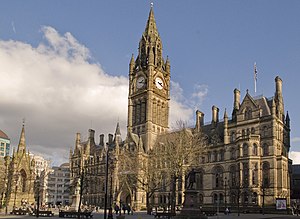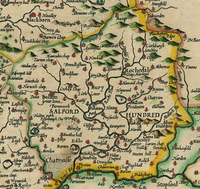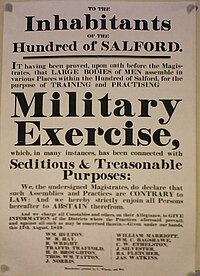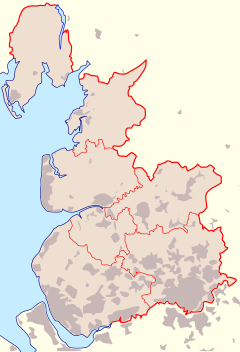Salfordshire: Difference between revisions
No edit summary |
|||
| (5 intermediate revisions by 3 users not shown) | |||
| Line 1: | Line 1: | ||
[[File:Manchester Town Hall from Lloyd St.jpg|right|thumb|300px|Manchester Town Hall]] | [[File:Manchester Town Hall from Lloyd St.jpg|right|thumb|300px|Manchester Town Hall]] | ||
{{Hundreds of Lancashire map}} | {{Hundreds of Lancashire map}} | ||
'''Salfordshire''' or '''The Hundred of Salford''' is one of the six hundreds of [[Lancashire]]. The hundred has also been known as the '''Royal Manor of Salford'''<ref>{{cite web|url=http://www.salford.gov.uk/leisure/salfordlocalhistory.htm|title=Salford's Local History|date=25 May 2004|format=http|accessdate=13 November 2007|publisher=salford.gov.uk|author=Salford City Council|authorlink=City of Salford}}</ref> and the '''Salford wapentake'''.<ref name="Mancuniensis10">{{Harvnb|Hollingworth|1839|p=10}}.</ref><ref name="GM Gazetteer"/> | '''Salfordshire''' or '''The Hundred of Salford''' is one of the six hundreds of [[Lancashire]]. The hundred has also been known as the '''Royal Manor of Salford'''<ref>{{cite web|url=http://www.salford.gov.uk/leisure/salfordlocalhistory.htm|title=Salford's Local History|date=25 May 2004|format=http|accessdate=13 November 2007|publisher=salford.gov.uk|author=Salford City Council|authorlink=City of Salford}}</ref> and the '''Salford wapentake'''.<ref name="Mancuniensis10">{{Harvnb|Hollingworth|1839|p=10}}.</ref><ref name="GM Gazetteer"/> It is the most populous of the hundreds, with a population of 1,836,589 in 2011. | ||
==Origins== | ==Origins== | ||
| Line 15: | Line 15: | ||
</ref> Exceptionally for hundred courts, Salford's remained active until the 19th century.<ref name="GM Gazetteer">{{cite web |url=http://www.gmcro.co.uk/Guides/Gazeteer/gazzs.htm |title=Greater Manchester Gazetteer|publisher=Greater Manchester County Record Office|accessdate=21 February 2008|at=Places names - S|archivedate=18 July 2011|archiveurl=http://web.archive.org/web/20110718144349/http://www.gmcro.co.uk/Guides/Gazeteer/gazzs.htm}}</ref> | </ref> Exceptionally for hundred courts, Salford's remained active until the 19th century.<ref name="GM Gazetteer">{{cite web |url=http://www.gmcro.co.uk/Guides/Gazeteer/gazzs.htm |title=Greater Manchester Gazetteer|publisher=Greater Manchester County Record Office|accessdate=21 February 2008|at=Places names - S|archivedate=18 July 2011|archiveurl=http://web.archive.org/web/20110718144349/http://www.gmcro.co.uk/Guides/Gazeteer/gazzs.htm}}</ref> | ||
The lordship of Salford passed with the [[Duchy of Lancaster]] to the Crown, and a serjeant or bailiff was appointed to administer the hundred on the king's behalf.<ref name=vch>History of the County of | The lordship of Salford passed with the [[Duchy of Lancaster]] to the Crown, and a serjeant or bailiff was appointed to administer the hundred on the king's behalf.<ref name=vch>History of the County of Lancaster ([[Victoria County History]])</ref> In 1436 the office of Hereditary Steward of the Wapentake of Salfordshire was granted to Sir Robert Molyneux of Sefton. The office was held by Sir Robert's successors, the Earls of Sefton until 1972.<ref name=vch/> | ||
The '''Portmote of the Borough of Salford''' merged with the Hundred Court in the 17th century, and the latter body took over the administrative business of the manorial borough.<ref name=webb/> In 1792 police commissioners were established in Manchester and Salford, and the Hundred Court was left with few powers. By 1828 the activities of the court consisted of the following:<ref name=webb/> | The '''Portmote of the Borough of Salford''' merged with the Hundred Court in the 17th century, and the latter body took over the administrative business of the manorial borough.<ref name=webb/> In 1792 police commissioners were established in Manchester and Salford, and the Hundred Court was left with few powers. By 1828 the activities of the court consisted of the following:<ref name=webb/> | ||
| Line 26: | Line 26: | ||
In 1846 Salford Hundred Court was reformed to become a Court of Record with its jurisdiction extended to debts not exceeding fifty pounds in value.<ref name=prison/> In 1838 [[Manchester]] was incorporated as a municipal borough and granted its own court of record. The two courts were merged as the '''Salford Hundred Court of Record''' in 1869 by the '''Salford Hundred Court of Record Act 1868''' (31 & 32 Vict. c. cxxx.). The court had jurisdiction in personal actions only.<ref name=prison/><ref name=times1951>''Salford Hundred Court Inquiry'', The Times, October 9, 1951, p.8</ref> The municipal boroughs of [[Oldham]], [[Bolton]], [[Heywood, Lancashire|Heywood]] and [[Rochdale]] successively had their areas exempted from the jurisdiction of the Hundred Court by Order in Council or private Act of Parliament between 1878 and 1893.<ref name=webb/> | In 1846 Salford Hundred Court was reformed to become a Court of Record with its jurisdiction extended to debts not exceeding fifty pounds in value.<ref name=prison/> In 1838 [[Manchester]] was incorporated as a municipal borough and granted its own court of record. The two courts were merged as the '''Salford Hundred Court of Record''' in 1869 by the '''Salford Hundred Court of Record Act 1868''' (31 & 32 Vict. c. cxxx.). The court had jurisdiction in personal actions only.<ref name=prison/><ref name=times1951>''Salford Hundred Court Inquiry'', The Times, October 9, 1951, p.8</ref> The municipal boroughs of [[Oldham]], [[Bolton]], [[Heywood, Lancashire|Heywood]] and [[Rochdale]] successively had their areas exempted from the jurisdiction of the Hundred Court by Order in Council or private Act of Parliament between 1878 and 1893.<ref name=webb/> | ||
In 1910 a committee was appointed by the Chancellor of the Duchy of Lancaster to report on the practices, area and jurisdiction of the court, and whether it was "of benefit to the parties for whose use it was intended". One member of the three-man committee recommended the abolition of the court which had "little but its age to justify its continuance", while the majority called for amending legislation.<ref>''Salford Hundred Court. Departmental Committee's Report'', The Times, February 17, 1911, p.4</ref> Accordingly the '''Salford Hundred Court of Record Act 1911''' (1 & 2 Geo. 5 c. clxxii.) was passed to restrict the area of the court to the county court areas of Manchester and Salford and to alter its procedures and costs.<ref name=prison/><ref name="Salford Hundred Court">'' | In 1910 a committee was appointed by the Chancellor of the Duchy of Lancaster to report on the practices, area and jurisdiction of the court, and whether it was "of benefit to the parties for whose use it was intended". One member of the three-man committee recommended the abolition of the court which had "little but its age to justify its continuance", while the majority called for amending legislation.<ref>''Salford Hundred Court. Departmental Committee's Report'', The Times, February 17, 1911, p.4</ref> Accordingly, the '''Salford Hundred Court of Record Act 1911''' (1 & 2 Geo. 5 c. clxxii.) was passed to restrict the area of the court to the county court areas of Manchester and Salford and to alter its procedures and costs.<ref name=prison/><ref name="Salford Hundred Court">''The Times'', August 10, 1991, p.2</ref> | ||
Forty years later the court was again referred to a review committee.<ref>''Salford Hundred Court'', The Times, October 10, 1950, p.3</ref> The committee's report recommended that the court be retained as it provided "a popular and speedy remedy for a large number of litigants in the area".<ref name="times1951"/> In 1956 the court's area was extended across the [[River Mersey|Mersey]] into Cheshire to encompass the County Borough of Stockport.<ref>The Criminal Justice Administration Act 1956 (c 34), section 7</ref> | Forty years later the court was again referred to a review committee.<ref>''Salford Hundred Court'', The Times, October 10, 1950, p.3</ref> The committee's report recommended that the court be retained as it provided "a popular and speedy remedy for a large number of litigants in the area".<ref name="times1951"/> In 1956 the court's area was extended across the [[River Mersey|Mersey]] into Cheshire to encompass the entirety of the County Borough of Stockport.<ref>The Criminal Justice Administration Act 1956 (c 34), section 7</ref> | ||
The Court of Record for the Hundred of Salford was abolished by section 43(1)(d) of the Courts Act 1971. The last hereditary steward, the seventh Earl of Sefton died on 13 April 1972.<ref>''Obituary: The Earl of Sefton'', The Times, April 15, 1972, p.16</ref> | The Court of Record for the Hundred of Salford was abolished by section 43(1)(d) of the Courts Act 1971. The last hereditary steward, the seventh Earl of Sefton died on 13 April 1972.<ref>''Obituary: The Earl of Sefton'', The Times, April 15, 1972, p.16</ref> | ||
| Line 38: | Line 38: | ||
Salfordshire covers 212,170 acres of southeast Lancashire, including the county's greatest city, [[Manchester]]. | Salfordshire covers 212,170 acres of southeast Lancashire, including the county's greatest city, [[Manchester]]. | ||
Salfordshire comprised several parishes and townships during its history. These were not static, and changed according to the construction of churches and chapels and increases in population. For example, the township of [[Hundersfield]] was one of Rochdale parish's four original townships, but was itself split into four.<ref>{{brithist|53031 | Salfordshire comprised several parishes and townships during its history. These were not static, and changed according to the construction of churches and chapels and increases in population. For example, the township of [[Hundersfield]] was one of Rochdale parish's four original townships, but was itself split into four.<ref>{{brithist|53031}}</ref> Similarly, Prestwich-cum-Oldham was later split into two separate parishes of Prestwich and Oldham. | ||
In 1830, Salfordshire was documented to consist of the following parishes and townships:<ref>Cooper, ''Salford: An Illustrated History'', p. 8</ref> | In 1830, Salfordshire was documented to consist of the following parishes and townships:<ref>Cooper, ''Salford: An Illustrated History'', p. 8</ref> | ||
| Line 62: | Line 62: | ||
|- | |- | ||
|[[Eccles]] | |[[Eccles]] | ||
|[[Barton, Lancashire|Barton]], [[Pendleton]], [[Clifton, Lancashire|Clifton]], [[Worsley]], [[Pendlebury]] | |[[Barton, Lancashire|Barton]], [[Pendleton, Salford|Pendleton]], [[Clifton, Lancashire|Clifton]], [[Worsley]], [[Pendlebury]] | ||
|{{brithist|41440}} | |{{brithist|41440}} | ||
|- | |- | ||
| Line 70: | Line 70: | ||
|- | |- | ||
|[[Manchester]] | |[[Manchester]] | ||
|[[Ardwick]], [[Beswick, Lancashire|Beswick]], [[Blackley]], [[Bradford, Lancashire|Bradford]], [[Broughton, | |[[Ardwick]], [[Beswick, Lancashire|Beswick]], [[Blackley]], [[Bradford, Lancashire|Bradford]], [[Broughton, Salford|Broughton]], [[Burnage]], [[Cheetham Hill|Cheetham]], [[Chorlton-cum-Hardy]], [[Chorlton-on-Medlock]], [[Crumpsall]], [[Denton, Lancashire|Denton]], [[Didsbury]], [[Droylsden]], [[Failsworth]], [[Gorton]], [[Harpurhey]], [[Haughton, Greater Manchester|Haughton]], [[Heaton Norris]], [[Hulme]], [[Levenshulme]], [[Manchester]], [[Moss Side]], [[Moston, Lancashire|Moston]], [[Newton Heath|Newton]], [[Openshaw]], [[Reddish]], [[Rusholme]], [[Salford]], [[Stretford]], [[Withington]] | ||
|{{brithist|41404}} | |{{brithist|41404}} | ||
|- | |- | ||
Latest revision as of 17:27, 25 March 2022

Salfordshire or The Hundred of Salford is one of the six hundreds of Lancashire. The hundred has also been known as the Royal Manor of Salford[1] and the Salford wapentake.[2][3] It is the most populous of the hundreds, with a population of 1,836,589 in 2011.
Origins
It the Middle Ages it was not unknown for a whole hundred to fall into the control of a great landowner, be in single control as a manor, but this appears to have been the case in Salford from Anglo-Saxon times. According to the Domesday Book of 1086, in 1066 King Edward held Salford, with its 3 hides and 12 ploughlands, its forest 3 leagues square with many heys and a hawks' eyry, and a hide in Radcliffe, where a second hide was held as a royal manor. The churches of the manor of Manchester had a plough-land in Manchester. The rest of the manor or hundred, including Rochdale, was divided into twenty-one berewicks, each held by a thegn, assessed as 11½ hides and 10½ plough-lands, with extensive woodlands. The whole manor rendered £37 4s. for farm of the plough-lands. In 1086 the demesne was worth 100s.; there were two ploughs and serfs and villeins with one plough; and by the grant of Roger of Poitou five knights held 3 hides and 7 ploughlands, in which were thegns, villeins, and others, including a priest, having thirty-two ploughs; and the whole was worth £7. (fn. 1) The area was probably much the same as that of the existing hundred.[4]
The Salford Hundred was recorded in Domesday as part of the territory of Inter Ripam et Mersam or "Between Ribble and Mersey", which was bundled up with the records about Cheshire, though it cannot be said clearly to have been part of Cheshire.[5][6][7]
The area became a subdivision of the County Palatine of Lancaster (or Lancashire) on its creation in 1182.
Salford Hundred Court

The Salford Hundred retained a separate jurisdiction for the administration of justice, known as the Court Leet, View of frankpledge, and Court of Record of our Sovereign Lord the King for his Hundred or Wapentake of Salford.[8] Exceptionally for hundred courts, Salford's remained active until the 19th century.[3]
The lordship of Salford passed with the Duchy of Lancaster to the Crown, and a serjeant or bailiff was appointed to administer the hundred on the king's behalf.[9] In 1436 the office of Hereditary Steward of the Wapentake of Salfordshire was granted to Sir Robert Molyneux of Sefton. The office was held by Sir Robert's successors, the Earls of Sefton until 1972.[9]
The Portmote of the Borough of Salford merged with the Hundred Court in the 17th century, and the latter body took over the administrative business of the manorial borough.[8] In 1792 police commissioners were established in Manchester and Salford, and the Hundred Court was left with few powers. By 1828 the activities of the court consisted of the following:[8]
- A twice-yearly meeting of jury-men chose the borough reeve of Salford, along with two constables, a dog-muzzler, ale-taster and inspectors of flesh and fish for the town. The meeting also appointed constables in those townships that did not possess their own court leet. In these townships it also possessed powers to deal with noxious smells and smoke from factories, clearing obstructions of the highway, fencing of roads, foul ditches and enforcement of weights and measures.
- A three-weekly court for the recovery of debts of less than forty shillings. These were held every third Thursday by one of three deputy stewards (usually prominent local solicitors) appointed by the Earl of Sefton.[10]
Reform

In 1846 Salford Hundred Court was reformed to become a Court of Record with its jurisdiction extended to debts not exceeding fifty pounds in value.[10] In 1838 Manchester was incorporated as a municipal borough and granted its own court of record. The two courts were merged as the Salford Hundred Court of Record in 1869 by the Salford Hundred Court of Record Act 1868 (31 & 32 Vict. c. cxxx.). The court had jurisdiction in personal actions only.[10][11] The municipal boroughs of Oldham, Bolton, Heywood and Rochdale successively had their areas exempted from the jurisdiction of the Hundred Court by Order in Council or private Act of Parliament between 1878 and 1893.[8]
In 1910 a committee was appointed by the Chancellor of the Duchy of Lancaster to report on the practices, area and jurisdiction of the court, and whether it was "of benefit to the parties for whose use it was intended". One member of the three-man committee recommended the abolition of the court which had "little but its age to justify its continuance", while the majority called for amending legislation.[12] Accordingly, the Salford Hundred Court of Record Act 1911 (1 & 2 Geo. 5 c. clxxii.) was passed to restrict the area of the court to the county court areas of Manchester and Salford and to alter its procedures and costs.[10][13]
Forty years later the court was again referred to a review committee.[14] The committee's report recommended that the court be retained as it provided "a popular and speedy remedy for a large number of litigants in the area".[11] In 1956 the court's area was extended across the Mersey into Cheshire to encompass the entirety of the County Borough of Stockport.[15]
The Court of Record for the Hundred of Salford was abolished by section 43(1)(d) of the Courts Act 1971. The last hereditary steward, the seventh Earl of Sefton died on 13 April 1972.[16]
Prisons
Separate places of detention were maintained for the hundred: the New Bailey Prison in Salford, which was replaced by Strangeways Prison in 1868.[10]
Areas
Salfordshire covers 212,170 acres of southeast Lancashire, including the county's greatest city, Manchester.
Salfordshire comprised several parishes and townships during its history. These were not static, and changed according to the construction of churches and chapels and increases in population. For example, the township of Hundersfield was one of Rochdale parish's four original townships, but was itself split into four.[17] Similarly, Prestwich-cum-Oldham was later split into two separate parishes of Prestwich and Oldham.
In 1830, Salfordshire was documented to consist of the following parishes and townships:[18]
Outside links
References
- ↑ City of Salford (25 May 2004). "Salford's Local History" (http). salford.gov.uk. http://www.salford.gov.uk/leisure/salfordlocalhistory.htm. Retrieved 13 November 2007.
- ↑ Hollingworth 1839, p. 10.
- ↑ 3.0 3.1 "Greater Manchester Gazetteer". Greater Manchester County Record Office. Places names - S. Archived from the original on 18 July 2011. http://web.archive.org/web/20110718144349/http://www.gmcro.co.uk/Guides/Gazeteer/gazzs.htm. Retrieved 21 February 2008.
- ↑ 'The hundred of Salford', A History of the County of Lancaster: Volume 4 (1911)
- ↑ Harris and Thacker (1987) write on page 252:
Certainly there were links between Cheshire and south Lancashire before 1000, when Wulfric Spot held lands in both territories. Wulfric's estates remained grouped together after his death, when they were left to his brother Aelfhelm, and indeed there still seems to have been some kind of connexion in 1086, when south Lancashire was surveyed together with Cheshire by the Domesday commissioners. Nevertheless, the two territories do seem to have been distinguished from one another in some way and it is not certain that the shire-moot and the reeves referred to in the south Lancashire section of Domesday were the Cheshire ones.
- ↑ Phillips and Phillips (2002). pp. 26–31.
- ↑ Crosby, A. (1996) writes on page 31:
The Domesday Survey (1086) included south Lancashire with Cheshire for convenience, but the Mersey, the name of which means 'boundary river' is known to have divided the kingdoms of Northumbria and Mercia and there is no doubt that this was the real boundary.
- ↑ 8.0 8.1 8.2 8.3 Sidney Webb; Beatrice Webb (1908). English Local Government from the Revolution to the Municipal Corporations Act: The Manor and the Borough, Part One. London: Longman's Green and Company. pp. 52–57
- ↑ 9.0 9.1 History of the County of Lancaster (Victoria County History)
- ↑ 10.0 10.1 10.2 10.3 10.4 "Prison and Court Records" (PDF). Manchester Library and Archives Service. http://www.manchester.gov.uk/downloads/Prison_and_Court_records.pdf. Retrieved 5 September 2008.
- ↑ 11.0 11.1 Salford Hundred Court Inquiry, The Times, October 9, 1951, p.8
- ↑ Salford Hundred Court. Departmental Committee's Report, The Times, February 17, 1911, p.4
- ↑ The Times, August 10, 1991, p.2
- ↑ Salford Hundred Court, The Times, October 10, 1950, p.3
- ↑ The Criminal Justice Administration Act 1956 (c 34), section 7
- ↑ Obituary: The Earl of Sefton, The Times, April 15, 1972, p.16
- ↑ [1]
- ↑ Cooper, Salford: An Illustrated History, p. 8
- ↑ The parish of Ashton-under-Lyne - Introduction, manor & boroughs
- Hollingworth, Richard (1839). Mancuniensis; Or, an History of the Towne of Manchester, and what is Most Memorable Concerning it. W. Willis
|
Amounderness • Blackburnshire • Leyland • Lonsdale • Salfordshire • West Derby |

